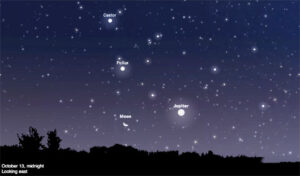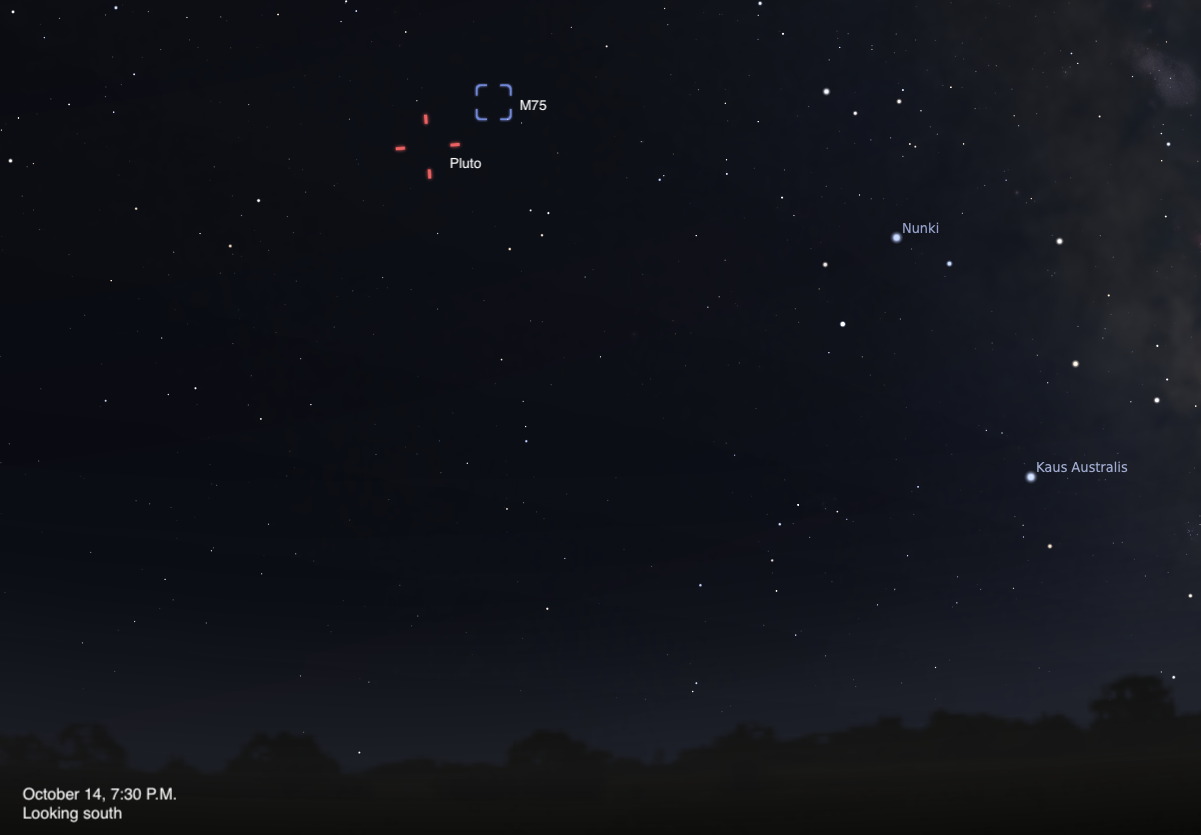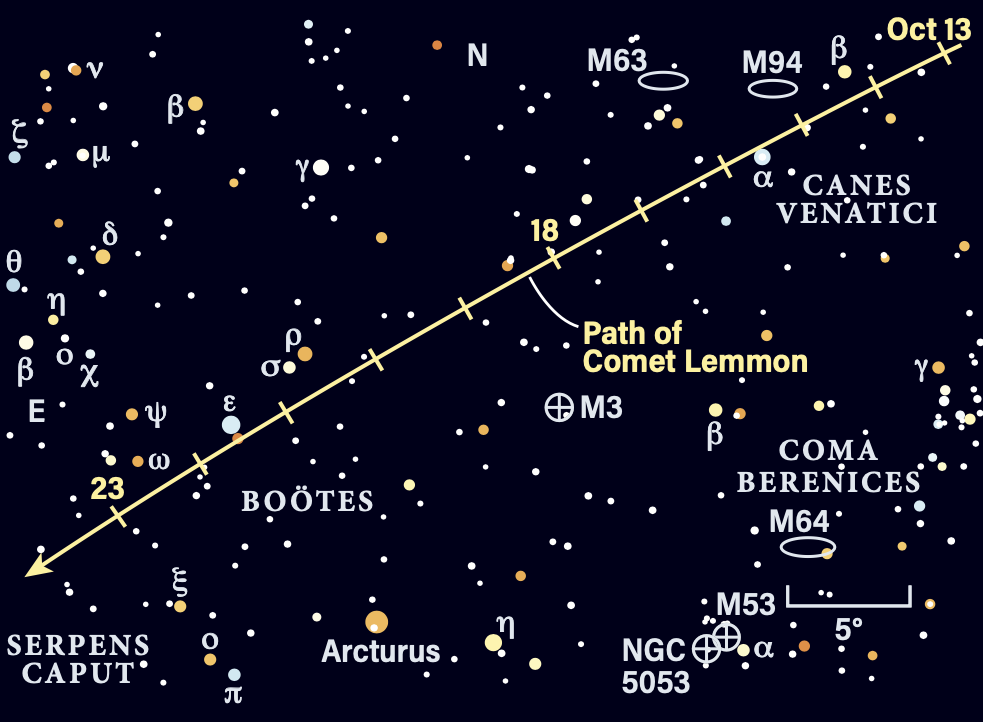Special to CosmicTribune.com, October 11, 2025
Excerpts from weekly Astronomy.com report.
Saturday, October 11
Last week, Io and Europa took a trip together across Jupiter, transiting the planet with their shadows. The moons’ resonant orbits mean similar events often repeat, and this morning is your chance to catch another one.
Bright Jupiter stands high above the eastern horizon during the early-morning predawn hours. By 4:30 A.M. EDT, Europa’s shadow is already visible on Jupiter’s large disk, while Io and Europa sit off to the planet’s east. Note that although it is Europa’s shadow on the cloud tops, Io appears physically closer to the planet, with Europa to Io’s east. Io’s shadow appears at 4:43 A.M. EDT, and by 4:50 A.M. EDT, both are readily visible.
 The two moons continue approaching Jupiter’s eastern limb, with Io reaching it first just over an hour later, at 5:58 A.M. EDT. The shadows are a bit more than halfway across the disk by this point, Europa’s shadow still leading. Europa’s transit begins at 6:43 A.M. EDT, as the shadows are approaching the western limb. The shadow transits end just three minutes apart, starting at 6:53 A.M. EDT.
The two moons continue approaching Jupiter’s eastern limb, with Io reaching it first just over an hour later, at 5:58 A.M. EDT. The shadows are a bit more than halfway across the disk by this point, Europa’s shadow still leading. Europa’s transit begins at 6:43 A.M. EDT, as the shadows are approaching the western limb. The shadow transits end just three minutes apart, starting at 6:53 A.M. EDT.
If you have cloudy skies or simply aren’t able to catch the transit, don’t worry — there will be another on the morning of the 18th, although the view will be better for those in the western half of the U.S.
Sunrise: 7:07 A.M.
Sunset: 6:26 P.M.
Moonrise: 9:38 P.M.
Moonset: 12:50 P.M.
Moon Phase: Waning gibbous (73%)
Sunday, October 12
Tonight we’re seeking the Saturn Nebula (NGC 7009), a planetary nebula that, as its name implies, looks like a ghostly version of the ringed planet.
You’ll find this nebula in western Aquarius, highest in the southern sky around 8 or 9 P.M. local daylight time. As a bonus, this is before the Moon rises and the sky should be dark, aiding the view.
NGC 7009 glows at 8th magnitude; snagging it through a telescope is relatively easy, though the larger your scope, the better the view. Once you’ve found it — just over 1° west of magnitude 4.5 Nu (ν) Aquarii — switch to high magnification to bring out details. In particular, this nebula comprises a spherical bubble as well as two projections, called ansae, which lend it the likeness of Saturn and earn it the common name.
NGC 7009 is a planetary nebula, but it has nothing to do with planets. Instead, it has formed as the aging star inside it dies, blowing off material into space and lighting it up from within. That central star shines at magnitude 11.5, also visible in a telescope.
Sunrise: 7:08 A.M.
Sunset: 6:24 P.M.
Moonrise: 10:45 P.M.
Moonset: 1:52 P.M.
Moon Phase: Waning gibbous (62%)
Monday, October 13
Last Quarter Moon occurs this afternoon at 2:13 P.M. EDT. A few hours later, the Moon passes 4° north of Jupiter at 6 P.M. EDT. The pair rises around midnight and are visible into the early-morning hours of October 14.
The Moon lies just to the lower left of bright Jupiter; the planet is now magnitude –2.2, the brightest point of light in that region of the sky, far outshining the stars. To Jupiter’s upper left are Castor and Pollux, the brightest stars in Gemini the Twins. Pollux is slightly brighter (magnitude 1.2) and glows a golden yellow. Castor (magnitude 1.6) is a blue-white star that easily splits into two through a telescope, revealing nearly twin stars some 5” apart.
Turning a telescope on Jupiter will show all four of its Galilean moons visible before dawn. Callisto is farthest east, with Io closest to the planet on that side and Europa between them. Ganymede lies alone to Jupiter’s west.
Sunrise: 7:09 A.M.
Sunset: 6:23 P.M.
Moonrise: 11:56 P.M.
Moonset: 2:41 P.M.
Moon Phase: Waning gibbous (51%)
 This chart shows the general locations of Pluto (red) and M75 (blue) in the southern sky. Note that a go-to scope is best for observing these objects, and only very large amateur telescopes will capture Pluto’s extremely faint light. Credit: Stellarium
This chart shows the general locations of Pluto (red) and M75 (blue) in the southern sky. Note that a go-to scope is best for observing these objects, and only very large amateur telescopes will capture Pluto’s extremely faint light. Credit: StellariumTuesday, October 14
Pluto is stationary in Capricornus at 4 A.M. EDT. If you want to try your luck with the distant dwarf planet, this evening will be a good opportunity, as the Moon dominates the predawn sky.
Pluto is highest around 7:30 P.M. local daylight time, when it stands about 25° high in the south. It is located in southwestern Capricornus about 7° northwest of 4th-magnitude Psi (ψ) Capricorni. However, the tiny world glows an incredibly faint magnitude 15.3, so you’ll need a large scope and dark observing site to spot it. A go-to drive is your best bet, as it can take you right to the correct field. Pluto’s disk is just 0.1” wide; it will look like a very dim, “flat” star.
If you don’t have a large scope, there’s still plenty in this region of the sky to enjoy. Nearby is Sagittarius, a constellation rife with deep-sky wonders such as M75, a globular cluster right over the border from Capricornus. It is located just 3° northwest of Pluto’s position, and again a go-to scope will land you right on it. Glowing at magnitude 8.5, this ancient ball of stars covers about 6’ on the sky. It appears so faint and compact because it is quite distant — some 67,500 light-years from Earth.
Sunrise: 7:10 A.M.
Sunset: 6:21 P.M.
Moonrise: —
Moonset: 3:20 P.M.
Moon Phase: Waning crescent (40%)
 This chart shows the path of Comet Lemmon from Oct. 13 to 23. Note that only deep-sky objects 8th magnitude or brighter are shown. Credit: Astronomy: Roen Kelly
This chart shows the path of Comet Lemmon from Oct. 13 to 23. Note that only deep-sky objects 8th magnitude or brighter are shown. Credit: Astronomy: Roen KellyWednesday, October 15
Comet C/2025 A6 (Lemmon) is currently making a splash across the sky, recently observed at magnitude 5.7 and visible in the predawn sky about an hour and a half before the Sun rises.
This morning the comet is in Canes Venatici and reaches some 25° high an hour before sunrise. Step outside and look northeast to locate the Big Dipper, now standing on the end of its handle. To the right of the handle is Canes Venatici, and Lemmon is just under 1.5° southeast of the constellation’s beta star, 4th-magnitude Chara, this morning.
You’ll need at least binoculars to spot Lemmon. If you’re using a telescope, Astronomy Associate Editor Michael Bakich recommends starting with a low-power eyepiece and working your way up once you’ve found the comet. Taking a long sky exposure with a smartphone may also pull the comet out of the background, so give that a try if you’re familiar with the night photography settings on your phone. Deeper astrophotography using a camera attached to your telescope may show the coma’s green glow, generated by diatomic carbon, which glows green when excited by sunlight.
Comet Lemmon will be closest to Earth on the 21st and likely shine brightest at that time. You can find additional finder charts and more tips on how to observe it here, and we’ll make sure to revisit it in this column throughout the month.
Sunrise: 7:11 A.M.
Sunset: 6:20 P.M.
Moonrise: 1:07 A.M.
Moonset: 3:51 P.M.
Moon Phase: Waning crescent (30%)
Thursday, October 16
The waning Moon has moved into Leo and stands close to Regulus, the Lion’s bright heart, in the early-morning sky today. An hour before sunrise, they are 40° high in the east, with the crescent Moon just to the upper right of Regulus.
Magnitude 1.4 Regulus shines some 150 times brighter than the Sun. It is not one star but a four-star system; the easiest companion to spot in a telescope lies 175” away and shines at 8th magnitude. This is itself a double, though the faint companion here requires a very large scope to view (it’s magnitude 13.5). The fourth star in the system is a white dwarf companion to the brighter Regulus A and cannot be seen.
Regulus anchors the asterism known as the Sickle, which outlines Leo the Lion’s regal head. This group of stars looks like a backwards question mark in the sky; see if you can spot it this morning as well, even with the Moon nearby.
The Moon will pass 1.2° due north of Regulus at 2 P.M. EDT. If you view the pair at the same time tomorrow morning, you’ll note the Moon has moved to the far lower left of Regulus.
Sunrise: 7:12 A.M.
Sunset: 6:18 P.M.
Moonrise: 2:16 A.M.
Moonset: 4:15 P.M.
Moon Phase: Waning crescent (21%)
Friday, October 17
Rising higher as the evening progresses is the constellation Perseus, perhaps most famous for its so-called Demon Star, the variable star Algol. But the Hero hosts many other treasures, including M34, a bright open cluster of young stars that should draw your gaze tonight.
You’ll find M34 already 40° high in the east by 9 P.M. local daylight time. It’s located in southwestern Perseus, just over 5° west-northwest of Algol and near Perseus’ border with neighboring Andromeda.
Glowing a bright magnitude 5.5, M34 is technically visible to the naked eye from a clear, dark site. You can view this cluster easily with binoculars or any telescope. It spans about the same size as the Full Moon in most optics, so it’s quite large; lower powers will show the cluster’s full extent, while higher powers will allow you to zoom in on a smaller region of the group but reveal fainter stars there. In all M34 contains about 100 stars and is about 180 million years old.
Sunrise: 7:13 A.M.
Sunset: 6:17 P.M.
Moonrise: 3:22 A.M.
Moonset: 4:37 P.M.
Moon Phase: Waning crescent (13%)

You must be logged in to post a comment Login